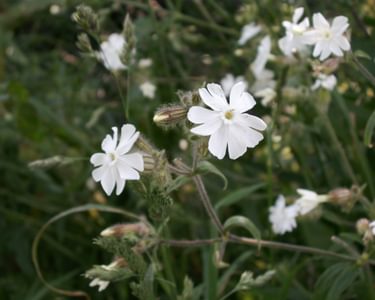White campion

Other names
cow-rattle, cockle, cuckoo flower, thunder-flower, white bachelors button, white robin
Latin names
Silene latifolia Poir. (S. alba, Lychnis alba, L. vespertina, Melandrium album)
Weed Type
Perennial Broad-leaved Weeds
Occurrence
White campion is an annual, biennial or short-lived perennial frequent on roadsides, in field borders, hedgerows, waste places and grassy banks. It is a weed of cultivated land mainly on light calcareous or sandy soils of pH 6.1 to 8.2. A lowland, sun-loving plant, it is most abundant in southern and eastern England. It grows less well in the shade. White campion occurs on the margins of woodland and can become established after felling or when coppicing has taken place. It disappears again once the trees regenerate and the habitat becomes shady. It does not grow well on waterlogged soils but is resistant to drought.
White campion is often found spreading into arable fields from the hedge bottom. It occurs in cereals, grass/clover mixtures and in fallow arable fields. In a survey of weeds of conventional winter oilseed rape in central southern England in 1985 it was found in 5% of the fields surveyed.
British plants are subspecies alba. White campion can hybridise with red campion (S. dioica). The hybrids have pink flowers.
Extracts from the leaves are toxic to mosquito larvae. It is a host of some important virus diseases.
Biology
White campion flowers from May to September. Male and female flowers occur on different plants. Female plants are usually more numerous in natural populations. Pollination is by night flying moths. Seeds start to become viable 2-3 weeks after flowering. The seeds ripen and the capsule opens 4-5 weeks later. Each seed capsule contains between 48 and 359 seeds. There are 5,000 to 15,000 seeds per plant.
Germination takes place whenever conditions are favourable. There may be some initial dormancy that is overcome by chilling. Germination is promoted by alternating temperatures and light. Fresh and dry-stored seed of white campion from separate populations in Europe differed in the proportion of seeds that germinated readily or were dormant. There were also differences in the rate of germination at certain key temperatures. Dry-stored seed was less dormant than fresh seed and germinated more readily over a range of temperatures.
Seed sown in the field and cultivated at intervals, emerged from February to October. There was a peak of seedling emergence from March to May and a smaller one in July.
Persistence and Spread
Seed recovered from archaeological digs and house demolitions is said to have germinated after 70 years burial. Seed buried in mineral soil retained up to 52% viability after 4 years depending on burial depth but had only 1-2% viability after 20 years. Seed buried in a peat soil at 26 cm retained little viability after just 1 year. Seed stored under granary conditions had 27% viability after 1 year but was no longer viable after 20 years.
White campion reproduces by seed and possibly by fragmentation of the rootstock. Ploughing can break up the plant and severed portions of rootstock may generate leafy stolons. There may be some dispersal of the seed when it is shaken from the capsule by the wind. The seed of white campion has occurred as an impurity in crop seeds. White campion was frequently introduced when sowing grass and clover. In a survey of weed seed contamination in cereal seed in drills ready for sowing on farm in spring 1970, white campion was found in 1% of the samples tested. Most of these were home saved seed. Viable seeds have also been found in cow manure.
Management
Plants growing in pastures, leys and along field borders should be cut periodically at ground level to prevent seeding. Hand pulling may be required in some crops.
In arable crops the plant does not survive ploughing, mechanical injury or desiccation following uprooting. White campion seed will not emerge from deep burial.
White campion survives burning on railway embankments and field margins. It is resistant to mowing, and decapitation merely ensures it will remain perennial. In the rosette stage it is unaffected by trampling although the tall flowering stems can be readily trodden down. There is some disagreement on whether or not white campion is eaten by rabbits.
The larvae of several species of moths feed on seeds within the capsules. Infection by Fusarium sp. causes rotting of the seeds in the soil and damping off of seedlings